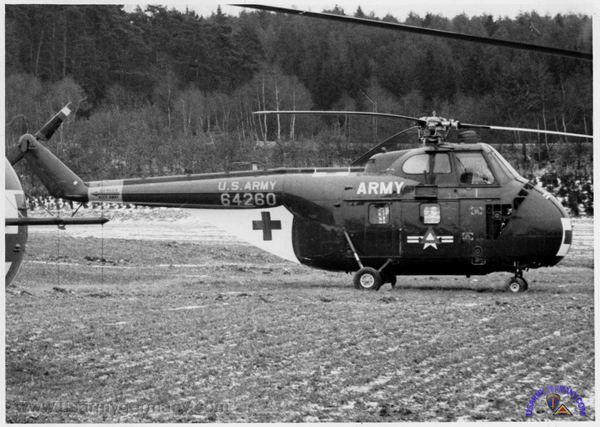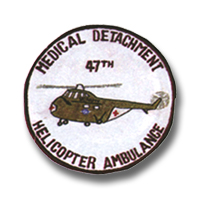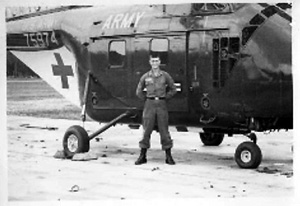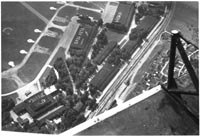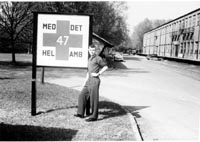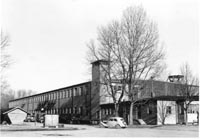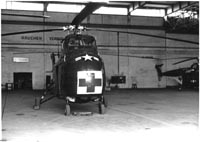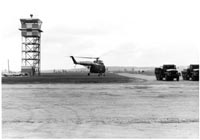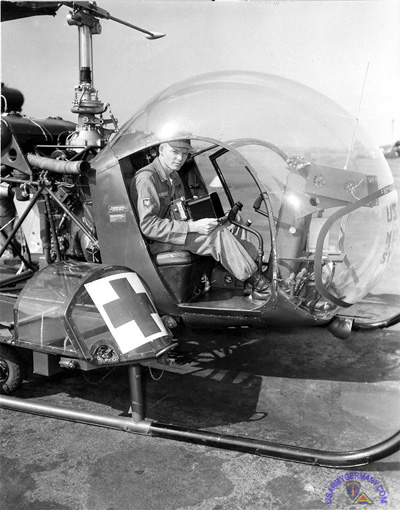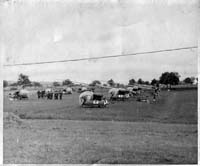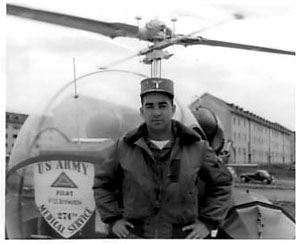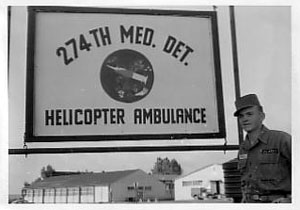| If you do
NOT see the Table of Contents frame to the left of this page, then
Click here to open 'USArmyGermany' frameset |
|||||||||||||
|
US Army Air Ambulance Units |
|||||||||||||
|
|
|||||||||||||
|
|||||||||||||
|
|
|||||||||||||
| Air Ambulance | |||||||||||||
 Helicopter Ambulance during FTX Cordon Bleu held in October 1955 |
|||||||||||||
| 47th Medical Detachment (Helicopter Ambulance) | |||||||||||||
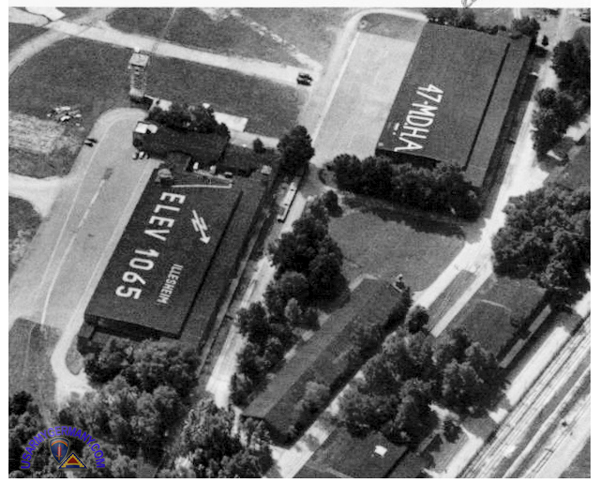 47th Med Det maintenance hangar, Illesheim AAF |
|||||||||||||
| 1956 | |||||||||||||
| (Source: STARS & STRIPES, July 7, 1956) | |||||||||||||
| The 47th Medical Helicopter Ambulance Detachment is a subordinate unit of the 56th Med Bn which is under the 30th Med Gp, 7th Army. CO of the detchment is Capt Karl A. Kuchera. The primary mission of the unit is organizational or field medical evacuation by air of casualties requiring medical treatment and furnishing of routine organizational or field evacuation when ground evacuation is not feasible. The unit's secondary mission is transportation of Army Medical Service personnel and supplies. The unit has six helicopters. Three of them are held ready at all times to take off in the case of an emergency. Each craft can evacuate two casualties at a time. There are two litter baskets - one on each side of the copter. The pilot can communicate with the patients through small windows on the side of the H-13 and on the litter pod. The pilot is near enough to the patients to assist them during the flight. Every officer (they are all from the Medical Service Corps) in the unit is a rated pilot. The pilots take an annual flight refresher course at the 7th Army Aviation School at Echterdingen. The enlisted men are qualified as aircraft mechanics and medical technicians. |
|||||||||||||
| 1958 | |||||||||||||
| (Source: 47th Med Det (HA) History submitted by Alfons Kraus, a German national who has been doing research on the History of the US Army Aviation in Germany for several years) | |||||||||||||
| 47th Medical Detachment (HA) The 47th Medical Detachment (HA) was activated on 15 July 1954 at Brooke Army Medical Center, Fort Sam Houston, Texas. The 47th was ordered to move to Europe and sailed from New York for Bremerhaven, Germany in November 1954. The unit was kept uninformed about its final destination. Finally the train conductor on the train they had taken from Bremerhaven told CPT Kuchera that they would be unloaded at Bad Windsheim, West Germany. There they were picked up by trucks from an ordnance battalion, which transported them to Illesheim Kaserne. |
|||||||||||||
|
|||||||||||||
| The deployment followed an urgent request by pro-Western Lebanese President Camille Chamoun for intervention in Lebanon on 15 July. Lebanon was beset with political unrest among its internal factions as the Arab world evolved into pro Western and anti Western factions. On 14 July, King Faisal of Iraq was murdered, prompting fear of the fall of Jordan, which was allied with Iraq, and a collapse of government in Lebanon. Two Marine battalion landing teams landed on Red Beach near Beirut International Airport on 15 July. The Army set into operation a contingency plan developed in late 1957, and sent an airborne battle group from the 24th Airborne Brigade in Germany as part of American Land Forces Task Force 201. The 47th Medical Detachment was one of the support elements of the Task Force that followed by ship. Its H-19Ds were flown from Illesheim to the docks at Bremerhaven, where the personnel and aircraft were loaded on the USS Comet, a prototype roll-on, roll-off ship between 22 and 26 July. On arrival in Beirut, the helicopters were off loaded on to narrow commercial piers where they were manhandled to the edge of the piers. The blades were unfolded and the engines started. With little clearance from the pier sheds, and little attention paid to the fact that they had been in sea storage for a week, the aircraft were flown out to sea over the port buildings and ships and to the Beirut International Airport, where camp was set up in tents in the 2000 year old olive groves east of the airport. The primary mission of the 47th was the combat support of the American Forces. It also provided twice a day sick call to Marine medical stations on the high ground around Beirut, and 24 hour on call duty at emergency sites. The aircraft also delivered medical supplies to civilian locations. Fortunately, there was no protracted armed conflict, although there were occasional clashes in the nearby mountains, and one of the unit aircraft took a sniper bullet through a rotor blade. In mid-October, the unit was loaded onto a small Navy carrier and transported to Leghorn, Italy. The flyable aircraft were flown back to Illesheim via France, since Austria, with its neutrality policy, would allow no overflights. The 47th was inactivated on 21 August 1961. Its assets were used to form the Second Platoon of the 421st Medical Company (AA) which was activated on that date. |
|||||||||||||
| (Source: Email from Bill McKee, 47th Med Det, 1959-1962) | |||||||||||||
I was attached to the 47th, at Illesheim Kaserne, as a helicopter mechanic from 28 Nov 1959 to 9 Apr 1962. I crewed H-19D 55-3214 for a little over a year. My first duty as crew chief was at Graf. then Hohenfels several times one week at a pop. I was in Wintershield I and II, Brick Bound, and one or two other training ops. |
|||||||||||||
|
|||||||||||||
| Not bad for 40 years, what? I have talked to Lucore and Ledkins in the past year but no one else. I was told that Capt Jack had passed away in Texas not long ago and that Ledkins had seen Sgt Tulloch not long ago. I did run in to Ltc. John W. Dean in Chu Lia RVN in 68, I was a civilian Tec REP for Lier Siegler. I have not been in touch with him since. One crew chief from a later time was Sgt Richard C. Harman who was in the Golden Knights for several years in the 60s. He died of a heart attack a few years back at an auto race. Another later member was Sp/4 Glenn C Payne. He is in Midland Texas retired from the postal service. I am the head of maintenance for the Ft. Smith Public Library in Ft. Smith, Ark. I do have some pictures of the H-19D air craft that were attached to the 47th, also some pictures of the personnel at the time. I remember it was the 30th Med Gp that we were under while I was at Illesheim APO 177. We used to have to make a commo check with the 30th when we were on CQ. I also remembered the a medic, SP/5 K. K. Kass. He was a WW II troop and had also been Heavy Weight Champion of USAEUR in the late 40s or early 50s. Also a PFC Cole, SP/4 Moore, and a old SP/5 - these guys were all medics who worked in the motor pool. I was also in the 47th when it became the 2nd PLT. 421st Med Det. (Air Amb.) in late 1961. At about the time the Berlin Wall was built and we all got extended for the convenience of the government. That is why I had over a three year on my enlistment. I could probably come up with most of the Officers and men of our unit when it was first organized. I do remember that the first company clerk at Nellingen was Dean Martin's oldest son, Craig Martin. He was part of one of the other small Med Det. Hel Amb units that made up the original 421 AA. Major Phiffer was the CO. and Martin married his daughter. Two of the HQ Plt Crew Chiefs were SP/5 W. Shell and SP/5 Don Butcher. I attended Helicopter Mechanics school and Ft. Eustis Va. with them summer and fall of 1959 we all shipped out for Germany on 17 Nov. 59. |
|||||||||||||
|
|||||||||||||
| 53rd Medical Detachment (Helicopter Ambulance) | |||||||||||||
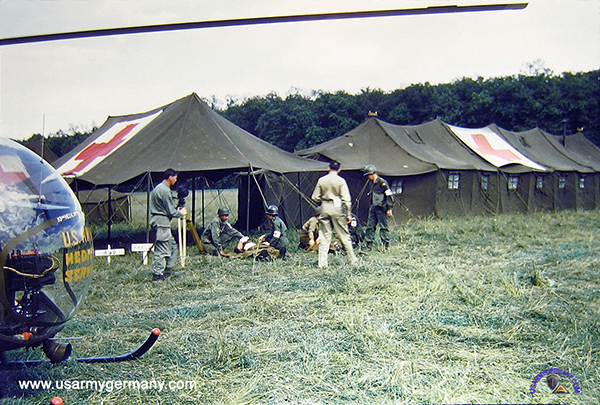 Bell H-13 Helicopter Ambulance of the 53rd Med Det during a training exercise |
|||||||||||||
| 1953 | |||||||||||||
| (Source: Email from Howard Black II) | |||||||||||||
I was assigned to the 53rd Medical Detachment, billeted at the Cambrai-Fritsch Kaserne, Darmstadt, Germany, at the end of September,1953 and ended my tour of duty at the beginning of March, 1955. Our airfield was located west of the city at Griesheim. The Stars and Stripes Newspaper (compound) was ajacent to the airfield.
There was another pilot who was of the Jewish faith, and if memory serves me, his name was Henschel (?) who also was a 1st Lt. I can picture his face and mustache, but for the life of me, his given name eludes me. The other pilots, whose names are listed above, are from a list I kept from one of our travels.
We were a close knit group of officers and enlisted, and we were taught enough to fly if an emergency ever happened. The 53rd was the first Helicopter Ambulance Detactment assigned to Europe. We traveled throughout West Germany to many American military locations, explaining why we were there and what we were able to do evacuating the wounded. Each demonstration ended with a comic show having one ship (helicopter) painted as "Dumbo the Clown," and exercising difficult stunts. Since I was the crew chief of Dumbo the Clown (ol'e #889 helicopter), sometimes at the end of the demonstration, I pretended I was holding the ship in the air as it hovered over me. I enjoyed my time in Darmstadt. It was 70% destroyed during the war and by the time I left many homes and buildings were well on there way to being rebuilt. There is a street leading from Heidelberger Strasse to the strasse leading to the kaserne. There were 3 story brownstone houses bombed out and families were living in the cellars of some of them. By the time I left, most were rebuilt and new single homes were built across the street. Wish I could remember the names of the streets.
This coming March, I will reach the ripe old age of 80, and if I am still here and remember more stories I will add them. |
|||||||||||||
| 1954 | |||||||||||||
| (Source: STARS & STRIPES, May 2, 1954) | |||||||||||||
| The 53rd Medical Detachment (Helicopter Ambulance) located at Griesheim Airstrip is the first US Army helicopter ambulance unit to be stationed in Europe. (Webmaster note: we have conflicting claims - the S&S article in the 58th Med Det (HA) section below claims that the 58th was the first. I will do some further research to determine which one is correct. I believe it was the 53rd. It is, however, accurate that the 53rd and the 58th were the first two helicopter evacuation units to be stationed in Europe.) The 53rd is assigned to the Army Medical Service and takes its instructions directly from the 7th Army Surgeon at Stuttgart. Its mission is to evacuate by air casualties to the nearest medical treatment facility and to transport medical equipment and supplies to otherwise inaccessible areas. (Requests for assistance are directed to the 7th Army Surgeon. He in turn relays the requests to the 53rd. This speeds up the relief mission. In 1953, there were three major relief missions in which US Army air ambulance units in Europe took part -- a major flood in Holland in February; an earthquake in Greece in August; and rescue work after an avalanche in Austria in December.) The 53rd Med Det was formed at Fort Sam Houston in Oct 1952. The unit embarked for Europe on Sept 14, 1953. The unit is comprised of seven Medical Service Corps officers (all pilots) and 24 enlisted men who serve as medical aidmen, mechanics and administrative personnel. The Det is equipped with five Bell H-13E helicopters. The H-13E is a compact, highly maneuverable machine weighing only 1,475 pounds. Powered by a 200-hp air-cooled engine, the H-13E cruises at 60 mph and can reach a max speed of 98 mph. Its range is about 130 miles. The H-13E can carry up to three patients -- two strapped to external litters on either side of the helicopter and one sitting next to the pilot inside the cockpit. Alternatively, the helicopter can carry up to 500 pounds in medical supplies and equipment. The pilots are required to put in 100 hours helicopter flight time to maintain their helicopter proficiency. They are also trained to handle head, spinal and abdominal wounds (the type of injuries most commonly requiring air evac). Two enlisted men are assigned to each helicopter wthin the detachment. They maintain, clean and refuel the aircraft. Major repairs are done at the aviation maintenance (TAAM) units in Stuttgart (93rd OLAM Co, Echterdingen AAF) and Metz, France (45th TAAM Co, Frescaty AAF). The Sikorsky H-19 can carry from six to eight litters (inside). It travels at 85 mph and has a range of 200 miles. Some H-19s might be turned over to the helicopter ambulance units in the future for use. |
|||||||||||||
| 1958 | |||||||||||||
| (Source: STARS & STRIPES, February 10, 1958) | |||||||||||||
| In 1958, the 53rd Med Det is flying four H-13's and one H-19 . The Sikorsky H-19 has a capacity of 6 litters. | |||||||||||||
| 58th Medical Detachment (Helicopter Ambulance) |
|||||||||||||
| 1955 | |||||||||||||
| (Source: STARS & STRIPES, February 27, 1955) | |||||||||||||
The 58th Med Det (Helicopter)(Ambulance) at Salzburg Airport, Austria, was activated nearly two years ago, the first of its type to be organized in Europe. It was activated specifically for its ability to evacuate wounded soldiers in the inaccessible terrain of the Alps. Its responsibilities today range from searching for lost mountain climbers to staging flybys at command reviews. The unit has one copter (H-13) on emergency call at all times, ready to lift off within 15 minutes of a call. |
|||||||||||||
| 63rd Medical Detachment (Helicopter Ambulance) | |||||||||||||
| 1955 | |||||||||||||
| (Source: STARS & STRIPES, February 4, 1955) | |||||||||||||
| The 63rd Medical Det (Hel Amb) is the fifth medical helicopter evacuation unit to be assigned to Europe. The unit arrived on the Gen Geiger troopship at Bremerhaven POE on Feb 3, 1955. The unit's helicopters, five Bell H-13G's, arrived a month ago (also at Bremerhaven). The H-13G has a capacity of two litter patients and one walking wounded. The detachment will be attached to the Landstuhl Medical Center. |
|||||||||||||
| (Source: STARS & STRIPES, March 12, 1955) | |||||||||||||
| The 63rd Medical Helicopter Ambulance Detachment at Landstuhl Army Medical Center is the one of five such units in the European Theater. The five helicopter ambulance units are: |
|||||||||||||
Capt Willis G. Strawh is the CO of the 63rd. He was involved in the activation of three of the other Hel Amb units (47th, 53rd and 274th) in Germany. The 63rd has seven pilots and 22 enlisted men. It operates from an improvised airstrip at the Army hospital. The airstrip has a makeshift hangar. |
|||||||||||||
|
|
|||||||||||||
| 274th Medical Detachment (Helicopter Ambulance) | |||||||||||||
| 1954 - 19.. | |||||||||||||
| (Source: Email from Dr. Robert Romack) | |||||||||||||
| The 274th Med Det was formed at Brooke Air Base but attached to Brooke Army Hospital, both in San Antonio in approximately april 1954. We shared a WWI balloon hanger with Cpt. Kuchera (47th Med Det (HA)) and his similar group when they came in approx 3 months later. Each group had five H-13G Bells. The 274th was shipped thru New York to Bremerhaven and on to Stuttgart (Nellingen air field) in approx Aug 1954. The 274th assembled 5 new H-13G Bell helios at Stuttgart municipal airport to be used as helio ambulances. Cpt Cross was commander with five pilots incl. Lt's Smith, Harker, Bosworth, Meachem??? and Martin who's father was General Martin in charge of all U.S. military in Germany. |
|||||||||||||
|
|||||||||||||
|
|||||||||||||
| Related Links: | |||||||||||||
|
|||||||||||||

